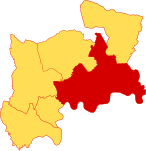Triathlon at the 2012 Summer Olympics

The triathlon events at the 2012 Summer Olympics were held in Hyde Park in London, United Kingdom, with the women's triathlon held on 4 August and the men's on 7 August. 110 triathletes from 39 countries competed with 55 men and 55 women competing. The races were held over the "international distance" (also called "Olympic distance") and consisted of 1.5 kilometres (0.93 mi) swimming, 43 kilometres (27 mi) road cycling, and 10 kilometres (6.2 mi) road running.The men's race was held on 7 August 2012. A group of six finished the 1,500-metre (1,600 yd) swim leg in a lead group. A large lead group of athletes were together at the end of the cycling leg but Alistair Brownlee broke away on the run to win the gold medal with Javier Gómez in second and Jonathan Brownlee in third. The women's race was held on 4 August 2012. A group of seven women finished the swim leg in a lead group. A large lead group of 22 athletes were together at the end of the cycling leg with a gap of over a minute and a half over the rest of the field. A group of five athletes formed on the running leg; Nicola Spirig, Lisa Nordén, Erin Densham, Sarah Groff and Helen Jenkins and held together for most of the run. Jenkins was dropped with two kilometres to go before Groff was dropped, also on the last lap. In the ensuing sprint finish Spirig beat Nordén by 15 centimetres in a photo finish with both athletes recording the same time. Densham finished two seconds behind Spirig to win the bronze medal.Great Britain topped the medal tally with one gold medal and one bronze medal, both in the men's race. Switzerland became the first nation to win two gold medals in Olympic triathlon and Australia won its fifth medal, the most in Olympic triathlon history to that point.
Excerpt from the Wikipedia article Triathlon at the 2012 Summer Olympics (License: CC BY-SA 3.0, Authors, Images).Triathlon at the 2012 Summer Olympics
South Carriage Drive, London Belgravia
Geographical coordinates (GPS) Address Nearby Places Show on map
Geographical coordinates (GPS)
| Latitude | Longitude |
|---|---|
| N 51.5086 ° | E -0.1636 ° |
Address
Hyde Park
South Carriage Drive
W1J 7NT London, Belgravia
England, United Kingdom
Open on Google Maps










